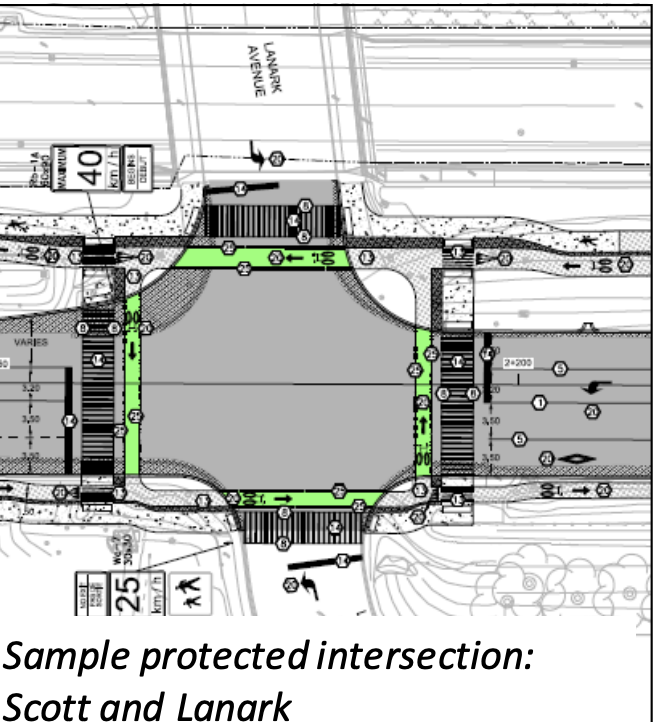On November 25, Councillor Jeff Leiper (Kitchissippi Ward) hosted an online public meeting on changes for cyclists and pedestrians coming to Scott Street between Churchill and Bayview. Here’s what you need to know.
Guest post by William van Geest.
First, in case you don’t know it, Scott St. is a central corridor for traffic travelling through west-side neighbourhoods like Hintonburg, Wellington Village, and Westboro. Despite the corridor’s importance, current facilities for pedestrians and cyclists are unideal: cyclists have to choose between sharing the road with fast-moving vehicles or using the cramped multi-use pathway (MUP), and pedestrians have to share the MUP or use a sidewalk beside the same fast-moving car traffic. To top things off, signs asking cyclists to dismount and walk their bike appear at many of the intersections along the MUP.
In brief: a bike-friendly reconfiguration is overdue.
The proposed reconfiguration involves a redistribution of pedestrian and bicycle traffic. Both sides of Scott St. will have dedicated pedestrian facilities, and instead of a single bidirectional MUP on the north side, bicycle traffic will become unidirectional, with a westbound lane on the north side of the road and an eastbound lane on the south side (see image). Separating bike lanes and pedestrians will be “tactile delineators” (or tactile indicators—surfaces whose different texture can be detected by those with low vision), and bike lanes will either be raised cycle tracks or be protected by pinned curbs (also known as pre-cast curbs; see image).
To make the space for the new facilities along this corridor, vehicle lanes will be reduced in the portion between Holland and Bayview:
- from Holland to Pinehurst: 5 to 4
- from Pinehurst to Pinhey: 4 to 3
- from Pinhey to Bayview: 4 to 2
While speed limit will not be decreased along the corridor (current speed is 50 km/h), City staff suggested that these lane reductions may themselves effect speed decreases.
The plan also provides for several “protected intersections” to be installed along the corridor. (For more on protected intersections, see this primer, or watch this brief video.) Because these treatments are new to many Ottawans, City staff plan a campaign to educate users on these configurations.

The changes will take place in two phases. Phase 1, slated to finish in Fall 2021, takes place between Churchill and Holland. During this phase, protected intersections will be installed at Churchill, Lanark, Island Park, Smirle, and Holland. Cyclists travelling eastbound on this segment’s new cycle track will be able to cross Holland to rejoin the existing MUP on the north side of Scott and continue eastbound. Phase 2, slated to finish in Fall 2022, takes place between Holland to Bayview. During this phase, with protected intersections to be installed at Parkdale and Carruthers.
City staff also discussed their hopes for rebuilding the south side of the street while preserving the above configurations. This rebuild would involve widening the sidewalk, elevating the cycle track, and planting trees in the boulevard. The trees would afford additional protection for cyclists—although to preserve sight lines with vehicles at pressure points, none would be planted near intersections. Funding has not yet been secured for these changes.
Finally, City staff also mentioned an offshoot of this corridor: a contraflow bike lane will be added during Phase 2 to Carruthers from Ladouceur to Scott. This addition, which will link up with the protected intersection at Carruthers and Scott, will improve north–south network connectivity.

In addition to the presentation (which can be viewed here, with a PDF of slides available here), staff fielded a host of questions from those in attendance, some of which pertained to the City’s overall vision for cycling infrastructure (begins at 19:16 in the video).
While Bike Ottawa largely welcomes these plans, there are several aspects that we’re concerned about and plan to raise with city staff.
Specifically, we’d like:
- an additional protected intersection at Carleton for people heading to the river
- additional mid-block signals at Merton and Ross
- curbs eliminated where they cross the cycle track at intersections
- the contraflow bike lane on Carruthers extended all the way to Wellington
- design should ensure that Road Services is able to adequately maintain the cycle ways year-round
- see the Bidirectional MUP maintained until the time that a cycling facility of sufficient width on the south side is constructed to allow for families to ride side by side
- confirmation that paths will meet TAC recommendations of 2+ m width
- a reduction in the speed limit for car traffic in the corridor
If you have anything feedback, or want to show your support for the lanes and changes, email Councillor Leiper’s office: jeff@KitchissippiWard.ca
